ORGANIZATION
Overview
Specified Nonprofit Corporation/NGO Pasifika Renaissance
2-10 Kitamyohoji-cho, Kashihara, Nara 634-0843, Japan.
Tel: +81-744-25-0121
E-mail:pasifika.renaissance%gmail.com (Please send an email by changing % to @)
Foundation date: September 14, 2014
Board Members
- Executive Director:Takuya Nagaoka

- Deputy Executive Director:Hiroyuki Saitoh(Anjo City Board of Education)

- Director:Reo Nagashima (Specially-Appointed Assistant Professor, Tokyo Seitoku University)

- Auditor:Yumi Yasaka Schultz (Development consultant)

- Auditor: Kaoru Ruluked

Advisors
- Ken’ichi Sudo (Director-General, Sakai City Museum)

- Junko Konishi (Professor, Okinawa Prefectural University of Arts)

- Masakazu Kawashima (Secretary General, NGO Micronesia Development Association)

Members (Regular Members)
Ben Schultz

Ben has been working across the Pacific assisting governments with the management of budgets and resources. This has seen him work in Fiji, Kiribati, Micronesia, Nauru, Samoa, Solomon Islands, Tonga, and Vanuatu. In addition, Ben organized orienteering in Kiribati and Vanuatu as well as supported the development of football in Kiribati.
Chihiro Shirakawa
After majoring in cultural anthropology and environmental science at a university, Chihiro worked on malaria control as a JOCV volunteer in Vanuatu. Triggered by this experience, he began to conduct anthropological research on such topics as traditional medicine, international cooperation, and magic in Vanuatu. He also engaged in filaria control as a WHO short-term expert in Samoa and Fiji. He is a Professor at the Graduate School of Human Science, Osaka University. His single-authored books are: “Kastom Meresin: An Anthropological Study of Traditional Medicine in Oceania” (Fukyosha, 2001, in Japanese), “Land, Tourism, and Culture in the South Pacific: Who Owns Traditional Culture?” (Akashi Shoten, 2005, in Japanese), “Representations of Melanesians on Japanese TV” (Fukyosha, 2014, in Japanese), and “Understanding Traditional Medicine in the South Pacific” (Rinsen Shoten, 2015, in Japanese). ![]()
Fusayo Kobayashi
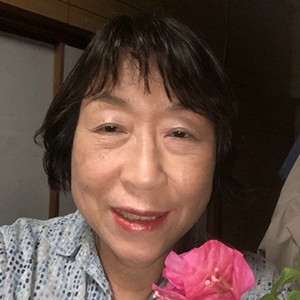
After working as a nurse at hospitals and companies and public health nurse in governments, Fusayo engaged in lifestyle disease control at the Division of Primary Health Care, Pohnpei State Department of Health and Social Services. She then worked as School Health Coordinator at the same Department, as Field Coordinator at Yap State Department of Resources and Development, and as a JICA expert engaging in a regional nurse training project. After returning to Japan, while teaching public health nursing and international nursing science at universities, she has been engaging in research and technical assistance on lifestyle disease control and the school health system in Pohnpei.
Hiroo Sasaki
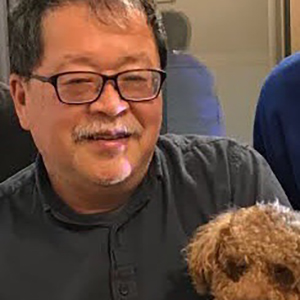
Hiroo had taught economics, especially theoretical economics and game theory, as a Professor at the Waseda University for many years (optionally retired in 2021). Triggered by his hobby, scuba diving, he got to know Micronesia and began a research project in the field of Micronesia, setting up an interdisciplinary research team, which consists of economists, cultural anthropologists, biologists, and historians. He obtained a research grant (Grant-in-Aid for Scientific Research (A)) from Japan Society for the Promotion of Science to conduct the project “Theoretical and Experimental Research on Money and Market System in the Pacific Island Countries” from a new angle . Currently, he is a Professor Emeritus at the Waseda University.
. Currently, he is a Professor Emeritus at the Waseda University.
Hiroyuki Saitoh

After majoring in archaeology at a university, Hiroyuki worked as a curator at the Anjo City Historical Museum. Then he worked for the Pohnpei State Historic Preservation Office in Micronesia as a JOCV volunteer on activities such as management of a museum, production of an exhibition of historical photos, investigations at archaeological sites, and documentation of Pohnpeian chiefly canoe (warasap) building. Currently, he works for the Anjo City Board of Education, taking charge of cultural property protection administration and promoting a historical town development, which utilizes historical resources and promotes public participation. His co-authored books include “Micronesia” (Travel Journal, 1999, in Japanese) and “Mikawa Province, Began Here!” (Yuzankaku, 2017, in Japanese).
Hisao Sekine

After majoring in archaeology in a university and working for a private company, Hisao worked at the Solomon Islands National Museum as a JOCV volunteer. Triggered by this experience, he has been engaging in cultural anthropology, regional development, Oceania island society studies, and “anthropology and development assistance” mainly in the field of the Solomon Islands. He is a Professor at the Faculty of Humanities and Social Sciences, University of Tsukuba. His single-authored books are “Alternative Modernity in the Solomon Islands: Conflict, Development and ‘Autonomous Dependance’” (University of Tsukuba Press, 2015, in Japanese) and “People Confronting with Development: Concept of “Development” and Political Leadership in the Solomon Islands” (Toyo Shuppan, 2001, in Japanese). ![]()
Ikuko Matsumoto
After majoring in educational assistance policy, Ikuko encountered Micronesia through her engagement in development cooperation in Africa and Asia-Pacific region during her work at international agencies. Based on her concerns on the structure of development cooperation and loans as well as her interests in culture and history in the Micronesia region, she currently engages in her doctoral research on colonization, modern history, and the role of Christianity in the region at the Graduate School of Applied Religious Studies, Sophia University.
Junko Konishi

After aspiring to conduct ethnomusicological research on traditional music on Yap, Micronesia, Junko was supervised by Osamu Yamaguchi, Professor Emeritus at the Osaka University, who conducted the first ethnomusicological research in Palau after World War II as a graduate student of University of Hawaii, and his supervisor Barbara B. Smith, Professor Emeritus at the University of Hawaii. Later her research has focused on the diffusion and changes of Micronesian marching dances and songs mixed with Japanese words spread during the Japanese administration. She also expanded her field to the Ogasawara Islands and Okinawa, whose inhabitants had interacted with the Japanese mandated Micronesia. After working as a Professor at the Shizuoka University, she became a Professor at the Okinawa Prefectural University of Arts in 2013. ![]()
Kaoru Ruluked

Grown up and educated in Tokyo, living in Palau. A writer, a mom, a wife, and an in-law of a typical big Palauan family. A Pacific Islands hopper, as a backpacker in Okinawa, Kaoru worked in Saipan and family life in Hawaii and Palau. She is curious about learning the local way and loves to write and tell about culture, people, economy, politics, history, anything of Palau and the Pacific Islands. Strong to have two sides of view, inside and outside, Tokyo and Islands.
Keiko Yokoyama

After working in the tourism industry for about 20 years, Keiko worked at the Yap Visitors Bureau in Micronesia and the Livingstone Tourism Association in Zambia as a JICA Senior Volunteer. In Yap, she took charge of tourism expos in Tokyo and Osaka and PR to Japan, by interacting with media and tour companies. It was through her encounters with stone money and traditional navigation in Yap that she deepened her ways of thinking and feeling of awe toward nature. She has also been engaging in activities to support Zambia, animal protection, and environmental problems.
Ken’ichi Sudo
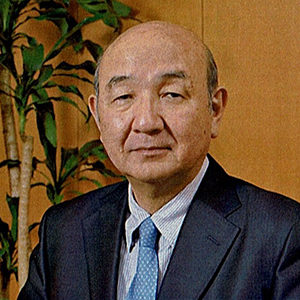
Probably due to his being island-bred (on Sado Island), he became interested in the lifestyle of the island people in Oceania and conducted fieldwork on an atoll in Chuuk State for five months in 1974. He also spent time on the outer island of Yap State for one and a half years, studying food, clothing and housing, family, and the system of society and politics. Participating in a two-day voyage, he also learned traditional navigation, which utilized stars, winds, and waves to sail for 1,000 km. He has conducted research on a large-scale migration to New Zealand and the United States of America from Tonga and environmentally damaging development by foreign capital and depletion of the forest, and island people’s resource management in the Solomon Islands. His major books include “The Structure of Matrilineal Society: Ethnography of Islands in the Coral Reef” (Kinokuniya Shoten, 1989, in Japanese) and “Anthropology on Oceania: Overseas Migration, Democracy, and Traditional Politics” (Fukyosha, 2009, in Japanese).
Koichi Takase
Koichi spent one year in Illinois State in the United States as an exchange student and also traveled to such countries as India, Mexico, Guatemala, and Belize. After graduation, he studied economics at the Graduate School, Boston University, and experienced an intern at World Bank. After completing his Ph.D., he started teaching Economics at the Fukuoka University and currently teaches at the Waseda University. He specialized in development economics for developing countries’ economies and has mainly studied official development assistance (ODA). Recently he began to participate in Dr. Hiroo Sasaki’s research project on economic experiments and fieldwork in Micronesia . After visiting all the states in the Federated States of Micronesia and conducting economic experiments at the University of Guam, they have been preparing for research toward the residents in Pohnpei and economic experiments at the College of Micronesia.
. After visiting all the states in the Federated States of Micronesia and conducting economic experiments at the University of Guam, they have been preparing for research toward the residents in Pohnpei and economic experiments at the College of Micronesia. 
Kyoko Miyazawa
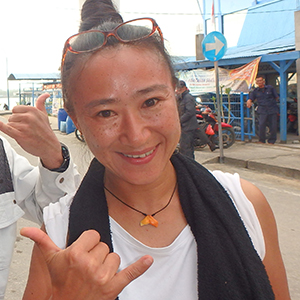
Being interested in trading under a trade wind and island life, Kyoko has apprenticed herself to people of Indonesia and Micronesian outer islands. In Oceania, working for a documentary television and video production company, Studio UMI Inc., she produced documentary films on traditional fishing, mat, barkcloth and preserved food making, and canoe building in such places as Marshall Islands, Micronesia, Papua New Guinea, Fiji, and Samoa. On Polowat Atoll, she participated in building a voyaging canoe and joined a voyage from Polowat to Guam (about 800 km), on which she produced a documentary film. ![]()
Masakazu Kawashima
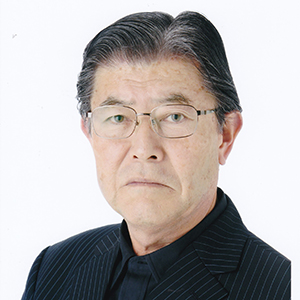
Masakazu worked for Kawasaki Heavy Industries Ltd. for a long time. After holding various important posts in labor unions, he served as the Chief Director of the Chiba Prefecture Headquarter of the National Federation of Workers and Consumers Insurance Cooperatives. During his work at the labor union, he got to know Micronesia in 1997 and established a voluntary organization. Later he initiated the establishment of a nonprofit organization, Micronesia Development Association in 2002, serving as the Secretary-General, and a local NGO in the Federated States of Micronesia (FSM).
Since then, he has visited the Micronesian region (the FSM, Palau, and the Marshall Islands) about 70 times and has guided several hundreds of individuals, company officials, and legislators of various levels there. He also engaged in joint development and installation of wind power generators with FSM Telecom, agricultural assistance (e.g., noni juice production), short-term training for the Xavier High School students in Japan, and educational assistance using the JOCA Scholarship Scheme. Recently he was involved in the establishment of NPO Pacific Ocean Co-Creation Organization, which aims in contributing to deepening the friendship between Japan and Pacific nations, and has been serving as the Director-General. CEO of Shima Inc.
Takuya Nagaoka
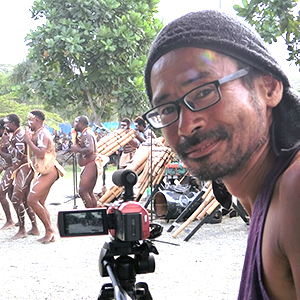
Takuya loved dinosaurs, fossils, and picking up ancient pottery and stone tools in gardens in his childhood. After graduating from a university, majoring in archaeology, he worked for the Pohnpei State Historic Preservation Office in Micronesia as a JOCV volunteer. He engaged in the opening and management of a museum and documented and held classes for traditional dances, loom weaving, and sailing canoe building. As he saw elders’ traditional knowledge and skills disappearing without passing down to the younger generation nor being documented properly there, he decided to pursue postgraduate studies at the University of Auckland, New Zealand, to engage in international cooperation in cultural areas in Oceania in the future. His research focused on the archaeology in the Solomon Islands there, while he also conducted oral tradition documentation projects, ethnomusicological research on the history of marching dances, and archaeological investigations in Micronesia. After acquiring a Ph.D. and returning to Japan, he initiated to establish Pasifika Renaissance and has been working in the field after the establishment. He serves as Advisor for NPO Micronesia Development Association and NPO Pacific Ocean Co-Creation Organization. “Islander impersonator” who has stayed in Micronesia for more than ten years and loves drinking kava. ![]()
Osamu Monden

President, Studio UMI Inc., a documentary television and video production company. Since Osamu engaged in producing a documentary film on a canoe, which sailed from Satawal Island, Micronesia, to Okinawa at the Okinawa International Ocean Exposition in 1975, he has been interested in the sea and people’s lives and continued to produce documentary films. More than 100 films produced by Studio UMI are exhibited at the Oceanic Culture Museum, which specializes in Oceania. His focus is on an area between Rapanui and Madagascar. He was awarded the Daido Life Foundation Special Award for Area Studies in 2010 and has written many books, including “Let’s Go to Southern Islands” (Chikuma Primer Books, 1991, in Japanese). ![]()
Reo Nagashima
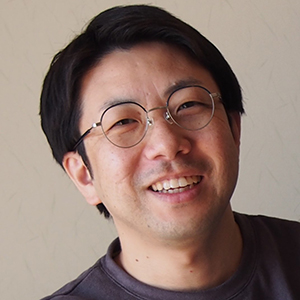
Reo began to conduct his research on the indigenous people’s movement in Guam in earnest at his graduate school and deepened his interest in such issues as the relationship between the United States of America and the Pacific Islands, including conflicts in the understanding of history, social inequality, and discrimination in those areas. He has conducted fieldwork in such areas as the Mariana Islands (Guam, Saipan, Tinian, and Rota) and Hawaii. His main research topics are American colonialism, racism, and militarism in the Pacific Islands. He also conducts research on memories of the war in Japan and the Marianas. He is a Specially-Appointed Assistant Professor, Faculty of International Studies, Tokyo Seitoku University. His book: “America and Guam: Colonialism, Racism, and Indigeneity” (Yushindo Kobunsha, 2015, in Japanese, was awarded the Japanese Society for Oceanic Studies Prize in 2016). ![]()
Yuji Inoue
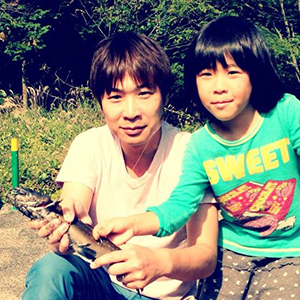
In addition to having stayed in New Zealand as a working holidaymaker for one year, Yuji traveled to Micronesia as well as in Southeast Asian and European countries.
Yumi Yasaka Schultz
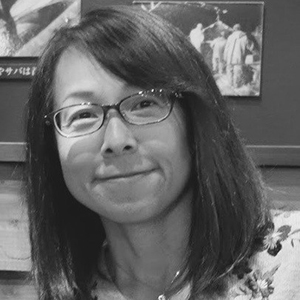
After working for NBC Nagasaki Broadcasting Company, Yumi worked at the radio station in Yap, Micronesia. Triggered by this experience, she has been working in such areas as media and project management in the Pacific Islands and Asian countries as a JICA technical expert and a development consultant. She majored in interdisciplinary informatics in a graduate school and studied development and media in such fields as Micronesia. Her books include “Living in Micronesia: The First TV News a JOCV Volunteer Produced” (Akashi Shoten, 2000, in Japanese).
Supporting Members
- Akiko Ikeguchi (Associate Professor, Yokohama National Universtiy, former JOCV volunteer in Micronesia)

- Hiroaki Shirakawa (Associate Professor, Nagoya University, visited Micronesia in 1995 and 2013)

- Hiroko Kawabe (housewife, former working holidaymaker and working in New Zealand)
- Kei Uekihara(former anthropology major student)
- Kanefusa Masuda (Visiting Professor, Ritsumeikan University)

- Masaya Takahashi (Yokohama City Office, former JOCV volunteer in Micronesia)
- Mitsunobu Mano (former Micronesian anthropology major student)
- Noriko Fujiki (Junior high school mathematics teacher, former JOCV volunteer in Micronesia)
- Ryota Okiguchi (international cooperation major graduate student/JICA Junior Expert, former JOCV volunteer in Micronesia)
- Satoru Watabe (Kitac Corporation, former JOCV volunteer in Micronesia)
- Shiho Ohno (nurse, former JOCV volunteer in Micronesia)
- Sora Shioya (nurse, visited Micronesia in 2019)
- Takako Takeda (former Embassy of Japan in the FSM staff)
- Takuro Furusawa (professor, Kyoto University, Solomon Islands area studies and ecological anthropology)

- Umeo Koganemaru (island revitalization of Mushima, Goto Islands, former JICA staff in charge of Oceania)
- Yasuo Ohno (President, JIN Corporation, former JOCV Coordinator in Micronesia)

- Yoshiko Isozaki (Japanese language teacher, former JOCV volunteer in Micronesia)
- Yoshiko Watanabe (scuba diving instructor, formerly working in Pohnpei and Chuuk)
- Yuko Shioya (medical student, visited Micronesia in 2019)
- Yuri Shirakawa (house wife)
Corporate Members

Morikaku Kanseidou(Website ![]() , Facebook
, Facebook ![]() )
)
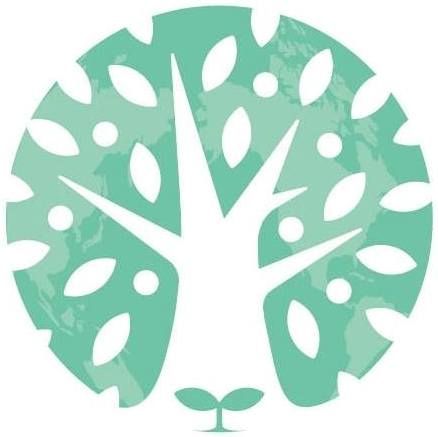
jpms Inc.(Website ![]() , Facebook
, Facebook ![]() )
)
Pro Bono
Davidson Syne (Design), Garry Scott LLB (Hons.)(English Proofreading, Solomon Islands Networking), David Vega (English proofreading), Josh Levy (English Proofreading, Micronesian History)
Volunteers
Nobuko Conroy (former JOCV volunteer in Micronesia), Mahany Lindquist (GIS Coordinator, Hamilton Library at University of Hawaiʻi at Manoa), Nono Toyoda (university student)
PARTNERS
Supporting Companies and Organizations (Corporate Members)
Morikaku Kanseidou(Website ![]() , Facebook
, Facebook ![]() )
)
jpms Inc.(Website ![]() , Facebook
, Facebook ![]() )
)
Outsourcing Organizations
- FSM Office of National Archives, Culture and Historic Preservation

- Pohnpei State Department of Resources and Development

- Yap State Historic Preservation Office

- The Association for the Promotion of International Cooperation (APIC)

Collaborative Organizations
- Pohnpei State Historic Preservation Office

- Pohnpei State Department of Education

- Yap State Historic Preservation Office

- Yap State Division of Media and Protocol

- NGO Kousapw Roasdi

- Micronesian Productions

- Takataka Eco-Village Conservation Foundation

- The International Information and Networking Centre for Intangible Cultural Heritage in the Asia-Pacific Region under the auspices of UNESCO (ICHCAP)

Material Support
Grants and Subsidies
- UNESCO: “Participation Programme”

- KDDI Foundation: “Social and Cultural Activity Grant”

- Ministry of Economy, Trade and Industry: “IT Introduction Subsidies”
Joint Fund Raising
- Softbank: fundraising platform “TsunagaruBokin”

- BOOKOFF Group Holdings: recycling item donation program “Kimochito.”

- TM Communication Service Ltd.: recycling item donation program “Otakara-Aid”

- NPO Donation Type Vending Machine Spread Association: donation type vending machine program

PUBLICATIONS
Newsletters
Reports/Deliverables
“Report on an Archaeological Survey of Five Malal Complexes, Yap Island, Micronesia” (Nagaoka 2017)
Report on an archaeological training conducted in response to the Yap State Historic Preservation Office’s request
“Pohnpeian Ceremonial Yam Feast” (Nagaoka 2018) 
Online exhibition on “Google Arts & Culture.”
“Sokehs Ridge Park Development Plan” (Nagaoka 2018)
Development plan for Sokehs Ridge Park, which was produced in response to the Pohnpei State Department of Resources and Development
“Report on Carolinian Traditional Navigation Course Documentation, Yap State in the Federated States of Micronesia” (Nagaoka 2020)
Report on Carolinian traditional navigation course documentation project, which was funded by UNESCO’s Participation Programme
“Mwoakilloa History Reader” (Nagaoka [ed.] 2021a)
Student reader of the history of Mwoakilloa Atoll, which was funded by UNESCO’s Participation Programme and was produced in collaboration with the Pohnpei State Department of Education
“Nukuoro History Reader” (Nagaoka [ed.] 2021b) 
Student reader of the history of Nukuoro Atoll, which was funded by UNESCO’s Participation Programme and was produced in collaboration with the Pohnpei State Department of Education
“Kapingamarangi History Reader” (Nagaoka [ed.] 2021c) 
Student reader of the history of Kapingamarangi Atoll, which was funded by UNESCO’s Participation Programme and was produced in collaboration with the Pohnpei State Department of Education
“Translation of ‘Ethnography of the Marshall Islands’ (Isoda 1928)” (Nagaoka [trans.] 2022) 
Translation of ethnography of the Marshall Islands during the Japanese colonial period
“Report on Pohnpei Studies History Reader Production Project, Pohnpei State in the Federated States of Micronesia” (Nagaoka 2022)
Report on Pohnpei Studies History Reader production project, which was funded by UNESCO’s Participation Programme
Others
“Nan Madol from the Perspective of Archaeology and Oral Tradition” (Nagaoka 2017) 
Osamu Kataoka, Takuya Nagaoka, and Tomo Ishimura “Survey Report on the Preservation Status of the Megalithic Complex of Nan Madol and Sites on Temwen Island, Pohnpei State, Federated States of Micronesia,” Report submitted to the FSM National and Pohnpei State Historic Preservation Office, pp. 94-101(Article on the characteristics of Nan Madol based on archaeology and oral tradition).
“Sailing canoe building on Mwoakilloa Atoll” (Nagaoka 2014)
In “Traditional Knowledge and Wisdom: Themes from the Pacific Islands.” ![]() Jeonbuk, Korea: International Information and Networking Centre for Intangible Cultural Heritage in the Asia-Pacific Region under the auspices of UNESCO)(Article on sailing canoe building techniques on Mwoakilloa Atoll)
Jeonbuk, Korea: International Information and Networking Centre for Intangible Cultural Heritage in the Asia-Pacific Region under the auspices of UNESCO)(Article on sailing canoe building techniques on Mwoakilloa Atoll)
“Pohnpei: Pwuken Kadaudok (Pali Keieu)”
Scotts Valley: CreateSpace Independent Publishing Platform ![]() (Book on traditional Pohnpeian culture, written by NGO Kousapw Roasdi Director Peterson Sam and edited by Nagaoka)
(Book on traditional Pohnpeian culture, written by NGO Kousapw Roasdi Director Peterson Sam and edited by Nagaoka)
NPO-RELATED MATERIALS
MEDIA
2014
“Research Associate Takuya Nagaoka” 
Tsuchiguruma (Newsletter of The Paleological Association of Japan, Inc.), 27:3, Nov 30, 2014 (in Japanese).
2015
“Japanese non-profit “Pasifika Renaissance” works to promote and preserve region’s heritage” 
The Kaselehlie Press, 15(9):2 (local Micronesian newspaper), April 8, 2015
“Preserve historical heritage in Oceania: NPO established by an Archaeologist in Kashihara records oral tradition” 
The Yomiuri Shinbun (Nara Edition), April 16, 2015 (in Japanese).
“Documentation of Stone Money Banks in Yap” 
Article on our archaeological training for Yap State Historic Preservation Office staff
UNESCO website (Pacific Office’s News), May 26, 2015.
Takuya Nagaoka, “Sailing Canoe Building on Mwoakilloa Atoll” 
ICH Courier: The Intangible Cultural Heritage Courier of Asia and the Pacific, 23:4 (UNESCO-affiliated institution ICHCAP’s quarterly magazine on the intangible cultural heritage of Asia and the Pacific
“Micronesian icons for May 2015” 
The Marianas Variety(Pasifika Renaissance and Takuya Nagaoka were selected in the “Culture & Tradition” section, in the Regional News section of a Saipan newspaper), May 11, 2015.
“Micronesia June 2015 Beauties and Models” 
The Marianas Variety(Takuya Nagaoka was selected as “Male Cultured Micronesian Model,” in Regional News section of a Saipan newspaper), July 8, 2015.
“Micronesian icons for June 2015”
The Marianas Variety (Takuya Nagaoka and Pasifika Renaissance were selected as “The Leading Male Icons for their Most Viewed Film Documentary on Micronesian Culture and Environment Preservation” and “The Best Micronesia Documentary Award” respectively, in Regional News section of a Saipan newspaper), July 28, 2015.
Takuya Nagaoka, “Preserving and Passing down Traditional Cultures and Historical Heritage in Oceania” 
Nanto Monthly Report” (published by the Nanto Economic Research Institute), 2015(9):52(in Japanese).
“Micronesian icons for July 2015” 
The Marianas Variety (Pasifika Renaissance and Takuya Nagaoka were selected as “Best Micronesia Documentary Work” of “Culture and Traditional Icons” section, in Regional News section of a Saipan newspaper), September 21, 2015.
“Micronesian icons for August 2015” 
The Marianas Variety (Pasifika Renaissance with Takuya Nagaoka and Takuya Nagaoka were selected as “Best Micronesia Culture & Environment Documentary” and “Best Cultural Documentary Photos” in “Culture & Tradition” section respectively, in Regional News section of a Saipan newspaper), October 7, 2015.
Takuya Nagaoka, “Preserving and revitalizing traditional cultures and historical heritage in the Pacific Islands” 
ICH Courier: The Intangible Cultural Heritage Courier of Asia and the Pacific, 25:13 (article on Pasifika Renaissance’s activities, published in a UNESCO-affiliated institution ICHCAP’s quarterly magazine on the intangible cultural heritage of Asia and the Pacific)
“Pasifika Renaissance invites individuals to document oral traditions” 
The Saipan Tribune (article on Pasifika Renaissance’s campaign to request interested individuals to record oral traditions, published in Regional News section of a Saipan newspaper), December 1, 2015.
2016
“Micronesian icons for December 2015” 
The Marianas Variety (Takuya Nagaoka was selected as “Best Cultural Photos” in the “Film and Photography” section, in the Regional News section of a Saipan newspaper), January 15, 2016.
“Pasifika Renaissance call for Pacific oral histories on video”
Asia Pacific Report (Pacific Media Centre’s news site in New Zealand) ![]() and Evening Post (news site in New Zealand)
and Evening Post (news site in New Zealand) ![]() , January 31, 2016.
, January 31, 2016.
Takuya Nagaoka, “Japanese university students researching Pohnpeian chief’s lost village”
The Kaselehlie Press, 16(6): 9, 11 (local Micronesian newspaper), February 15, 2016.
“Micronesian and their talents, 2015-2016” 
The Marianas Variety (Takuya Nagaoka was selected in “Cultural and Traditional Work” and “Cultural Educators” sections, in Regional News section of a Saipan newspaper), May 27, 2016.
“Micronesian icons for May 2016” 
The Marianas Variety (Takuya Nagaoka was selected as “Photo Artwork Contributors” in the “Travel, Environment, and Nutrition” section, in the Regional News section of a Saipan newspaper), June 10, 2016.
“Legendary Micronesian writers and June’s talented icons” 
The Marianas Variety (Takuya Nagaoka was selected as “Artists and Cultural Advocates” in “Culture & Tradition” section and “Photo Artwork Contributors” in “Environment, Nutrition, Fitness & Travel” section, in Regional News section of a Saipan newspaper), July 12, 2016.
“The Story Tellers Workshop on Nan Madol” 
UNESCO website (announcement on “Creating stories of Nan Madol” project, in which Pasifika Renaissance assisted), July 18, 2016.
Takuya Nagaoka, “Nan Madol became a World Heritage Site!” 
KDD Foundation’s blog, July 27, 2016(in Japanese).
“Micronesia’s July icons and the social network” 
The Marianas Variety (Pasifika Renaissance with Takuya Nagaoka was selected in the “Culture, Environment & Lifestyle” section, in the Regional News section of a Saipan newspaper), August 4, 2016.
“The legend of the ghost dance and Micronesia’s August icons” 
The Marianas Variety (Takuya Nagaoka was selected in the “Culture & Lifestyle” section, in the Regional News section of a Saipan newspaper), September 2, 2016.
“Dr. Takuya Nagaoka and the true essence of culture” 
The Marianas Variety (article on Pasifika Renaissance’s activities, in Regional News section of a Saipan newspaper), September 9, 2016.
“Dr. Takuya Nagaok’s Pohnpei research findings” 
The Marianas Variety, September 16, 2016.
“September 2016 Micronesia icons” 
The Marianas Variety (Takuya Nagaoka was selected in “Culture & Lifestyle” section, in Regional News section of a Saipan newspaper), October 6, 2016.
“2016 Micronesia October icons” 
The Marianas Variety (Takuya Nagaoka was selected in “Culture, Tradition and Lifestyle” section and Pasifika Renaissance and Takuya Nagaoka were selected in “Journalists” sections, in Regional News section of a Saipan newspaper), November 4, 2016.
Takuya Nagaoka, “New World Heritage Nan Madol: 1. What is Nan Madol?” 
Non-Profit-Organization Association for Micronesian Development News, 46:1‐2 (NGO Micronesian Development Association’s newsletter), November 9, 2016 (in Japanese).
“Dr. Takuya Nagaoka’s Saipan visit” 
The Marianas Variety (in Regional News section of a Saipan newspaper), November 14, 2016.
“November 2016 Micronesia icons” 
The Marianas Variety (Takuya Nagaoka was selected as “Culture Icons” in “Culture, Tradition and Lifestyle” section and Pasifika Renaissance and Takuya Nagaoka were selected in “Journalists” section, in Regional News section of a Saipan newspaper), December 9, 2016.
“The fascinating Micronesians and the memorable events of 2016” 
The Marianas Variety (Takuya Nagaoka was selected in “Education and Training Program” section, in Regional News section of a Saipan newspaper), December 30, 2016.
2017
Takuya Nagaoka, “New World Heritage Nan Madol: 2. Nan Madol in the island history” 
Non-Profit-Organization Association for Micronesian Development News, 47:1‐2 (NGO Micronesian Development Association’s newsletter), January 1, 2017(in Japanese).
“The Micronesia December icons and the best of 2016” 
The Marianas Variety (Takuya Nagaoka was selected as “Culture Icons” in “Best of Dec. 2016” section and Pasifika Renaissance and Takuya Nagaoka were selected in the “Journalists” section, in Regional News section of a Saipan newspaper), January 6, 2017.
“Mysterious megalithic islets photographed vividly” 
The Yomiuri Shinbun (Nara Edition), January 29, 2017(in Japanese) (newspaper article on the Nan Madol photo exhibition cosponsored by Pasifika Renaissance)
“This is the mysterious megalithic islets” 
The Yomiuri Shinbun (Nara Edition), February 3, 2017(in Japanese) (newspaper article on the Nan Madol photo exhibition cosponsored by Pasifika Renaissance)
“January 2017 Micronesia icons” 
The Marianas Variety (Takuya Nagaoka was selected as “Culture Icons” in “Culture, Tradition and Lifestyle” section and Pasifika Renaissance and Takuya Nagaoka were selected in “Journalists” section, in Regional News section of a Saipan newspaper), February 3, 2017.
“Micronesia February icons 2017” 
The Marianas Variety (Takuya Nagaoka was selected as “Culture Icons” in “Culture, Tradition and Lifestyle” section and Pasifika Renaissance and Takuya Nagaoka were selected in “Journalists” section, in Regional News section of a Saipan newspaper), March 3, 2017.
Takuya Nagaoka, “Documenting disappearing stories by video camera and publishing videos on the internet” 
KDDI Foundation, 8:14-15 (the KDDI Foundation’s bulletin), April 1, 2017 (in Japanese).
“Micronesia March 2017 icons” 
The Marianas Variety (Takuya Nagaoka was selected as “Cultural Advocacy and Preservation” in “Culture, Tradition and Lifestyle” section and Pasifika Renaissance and Takuya Nagaoka were selected in “Journalists” section, in Regional News section of a Saipan newspaper), April 7, 2017.
“Micronesia icons for April 2017” 
The Marianas Variety (Takuya Nagaoka was selected as “Cultural Advocacy and Preservation” in “Culture, Tradition and Lifestyle” section and Pasifika Renaissance and Takuya Nagaoka were selected in “Journalists” section, in Regional News section of a Saipan newspaper), May 5, 2017.
Takuya Nagaoka, “Pasifika Renaissance Shares over 200 Narrative Videos of Pohnpei State on YouTube” 
The Kaselehlie Press, 16(6):9, 11 (local Micronesian newspaper), May 8, 2017.
“The importance of island oral history” 
The Marianas Variety (article on Pasifika Renaissance’s activities, in Regional News section of a Saipan newspaper), May 12, 2017.
“World Heritage Nan Madol in Micronesia inscribed one year ago, 90% of the locals are not interested!?” 
News site “ganas,” (article on the Japan Consortium for International Cooperation in Cultural Heritage’s 21st Workshop “Endangered Heritage in Paradise: Focusing on Nan Madol in Micronesia,” including Takuya Nagaoka’s comments), August 7, 2017(in Japanese).
“Micronesia icons July 2017” 
The Marianas Variety (Takuya Nagaoka was selected as “Cultural Advocacy and Preservation” in “Culture, Tradition and Lifestyle” section and Pasifika Renaissance and Takuya Nagaoka were selected in “Journalists” section, in Regional News section of a Saipan newspaper), August 11, 2017.
“Micronesia icons, August 2017” 
The Marianas Variety (Takuya Nagaoka was selected as “Culture Icons” and “Cultural Advocacy and Preservation” in “Culture, Tradition and Lifestyle” section and Pasifika Renaissance and Takuya Nagaoka were selected in “Journalists” section, in Regional News section of a Saipan newspaper), September 8, 2017.
“Traditional knowledge and the environment” 
The Marianas Variety (article on Pasifika Renaissance’s activities, in Regional News section of a Saipan newspaper), September 13, 2017.
“September 2017 Micronesia icons” 
The Marianas Variety (Takuya Nagaoka was selected as “Culture Icons” and “Cultural Advocacy and Preservation” in “Culture, Tradition and Lifestyle” section and Pasifika Renaissance and Takuya Nagaoka were selected in “Journalists” section, in Regional News section of a Saipan newspaper), October 4, 2017.
“Micronesia’s October 2017 icons” 
The Marianas Variety (Takuya Nagaoka was selected as “Culture Icons” and “Cultural Advocacy and Preservation” in “Culture, Tradition and Lifestyle” section and Pasifika Renaissance and Takuya Nagaoka were selected in “Journalists” section, in Regional News section of a Saipan newspaper), November 6, 2017.
Takuya Nagaoka, “From Micronesia to YouTube, Pasifika Renaissance on Documenting Oral Tradition” 
ICH Courier e-News, 40 (UNESCO-affiliated institution ICHCAP’s newsletter on the intangible cultural heritage of Asia and the Pacific), November 17, 2017.
“Micronesia’s November icons” 
The Marianas Variety (Takuya Nagaoka was selected as “Cultural Advocacy and Preservation” in “Culture, Tradition and Lifestyle” section and Pasifika Renaissance and Takuya Nagaoka were selected in “Journalists” section, in Regional News section of a Saipan newspaper), December 8, 2017.
2018
“Micronesian’s fascinating people and memorable events of 2017” 
The Marianas Variety (Takuya Nagaoka was selected in “Education, Information, Training Programs” section, in Regional News section of a Saipan newspaper), January 8, 2018.
“Micronesia’s January 2018 icons” 
The Marianas Variety (Takuya Nagaoka was selected as “Cultural Advocacy and Preservation” in “Culture, Tradition and Lifestyle” section and Pasifika Renaissance and Takuya Nagaoka were selected in “Journalists” section, in Regional News section of a Saipan newspaper), February 7, 2018.
“Micronesia’s February 2018 icons” 
The Marianas Variety (Takuya Nagaoka was selected in “Educators” section and Pasifika Renaissance and Takuya Nagaoka were selected in “Journalists” section, in Regional News section of a Saipan newspaper), March 5, 2018.
“Micronesia March 2018 icons” 
The Marianas Variety (Takuya Nagaoka was selected in “Educators” section and Pasifika Renaissance and Takuya Nagaoka were selected in “Journalists” section, in Regional News section of a Saipan newspaper), April 6, 2018.
Takuya Nagaoka, “Pohnpei celebrates Cultural Day 2018” 
The Kaselehlie Press, 18(9):16 (local Micronesian newspaper), April 9, 2018.
“Micronesia’s April 2018 icons” 
The Marianas Variety (Takuya Nagaoka was selected as “Culture Icons” in “Culture, Tradition and Lifestyle” section and was selected in “Educators” section, and Pasifika Renaissance and Takuya Nagaoka were selected in “Journalists” section, in Regional News section of a Saipan newspaper), May 4, 2018.
Takuya Nagaoka and Jason Barnabas, “New radio program “Nahlikend En Leng” started in Pohnpei!” 
The Kaselehlie Press, 18(11):3 (local Micronesian newspaper), May 11, 2018 ![]() , The Marianas Variety (in Regional News section of a Saipan newspaper) and ICH News (UNESCO-affiliated institution ICHCAP’s newsletter on the intangible cultural heritage of Asia and the Pacific)
, The Marianas Variety (in Regional News section of a Saipan newspaper) and ICH News (UNESCO-affiliated institution ICHCAP’s newsletter on the intangible cultural heritage of Asia and the Pacific) ![]()
“Micronesia region’s June 2018 icons” 
The Marianas Variety (Takuya Nagaoka was selected as “Cultural Film” in “Culture, Tradition and Lifestyle” section and Pasifika Renaissance and Takuya Nagaoka were selected in “Journalists” section, in Regional News section of a Saipan newspaper), July 6, 2018.
Takuya Nagaoka and Peterson Sam, “Book on Pohnpeian traditional culture has just published!” 
The Kaselehlie Press, 18(14):6 (local Micronesian newspaper), July 12, 2018.
“Micronesian talents 2017” 
The Marianas Variety (Takuya Nagaoka was selected for cultural videos in the “Culture Educators” section, in the Regional News section of a Saipan newspaper), July 28, 2018.
“Micronesia region’s July 2018 icons” 
The Marianas Variety (Pasifika Renaissance and Takuya Nagaoka were selected as “Cultural Film” and “Culture Icons” respectively in “Culture, Tradition, and Lifestyle” and Takuya Nagaoka and Pasifika Renaissance were selected in “Journalists” section, in Regional News section of a Saipan newspaper), August 3, 2018.
“Micronesia region’s September 2018 icons” 
The Marianas Variety (Takuya Nagaoka was selected in “Educators” section and Pasifika Renaissance and Takuya Nagaoka were selected in “Journalists” section, in Regional News section of a Saipan newspaper), in Regional News section of a Saipan newspaper), October 5, 2018.
2019
Takuya Nagaoka, Rintaro Ono, and Jason Lebehn, “New archaeological research project started in Pohnpei” 
The Kaselehlie Press, 19(7):7, March 18, 2019.
2020
Takuya Nagaoka, “First-ever educational videos on traditional Carolinian navigation online now” 
The Kaselehlie Press, 20(15):2 (local Micronesian newspaper), July 15, 2020.
2021
Takuya Nagaoka and Peter Sheppard, “New information from an old stone adze found in Pohnpei” 
The Kaselehlie Press, 21(2):8 (local Micronesian newspaper), January 20, 2021.
REQUESTING FOR PUBLIC LECTURES, MEDIA INTERVIEWS, AND CONSULTANCY
We can make presentations on such topics as culture and history in Oceania, international cooperation, and Pasifika Renaissance’s efforts to schools and the public. We also accept media interviews on Pasifika Renaissance’s activities and the situation surrounding the traditional (e.g., translations of Japanese documents) culture in Oceania and can provide relevant photographs and videos. Further, we do consultancy, research, writings, and translations on Oceania. Please feel free to make an inquiry or contact us.

